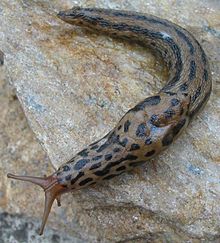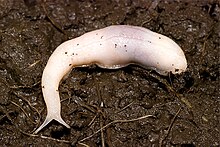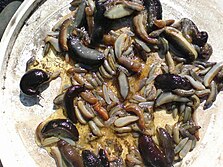Nudibranch

Slugs are snails that their original housing have largely reduced or moved it into the soft body inside. At least in the adult stage, they can no longer retreat into their housing for protection. Nudibranchs do not form a uniform systematic group, but the process of shell reduction has taken place convergent in different groups of snails. Some families even include shell snails and nudibranchs or "half- slugs ". In general, the term nudibranch is restricted to representatives of the terrestrial pulmonate, although the process of shell reduction has also occurred convergently in some groups of marine slugs . These are then usually called sea slugs to distinguish them . Primarily one understands under this name the largest and best-known group of nudibranchs living in the sea, the nudibranchs (Nudibranchia).
The shell of the snail - advantages and disadvantages
The shell of the snail is an exoskeleton . It is an original characteristic of snails that can already be assumed for the last common progeny of all snails. The ancestral species lived in the sea at the beginning of the Cambrian and inherited this characteristic to all groups that emerged from it. It served the parent species as a protective housing into which the animal could retreat when threatened. The mouth of the case could probably also be closed with an operculum back then . However, even this housing only offers limited protection against predators, as the numerous examples of specialized snail predators show. In the course of evolution , this (protective) housing has undergone a wide variety of modifications, as shown by the great variety of shapes of fossil and modern snails. Among the snails there are some groups that have partially, largely or completely reduced the shell. These groups have developed other protective mechanisms or do not (no longer) need the protection of the housing due to their way of life. For example, the nudibranchs (nudibranchia) that live in the sea are extremely poisonous and warn potential predators with conspicuous warning colors . Many land slugs spend much of their lives in the earth. Other groups protect themselves by secreting copious amounts of mucus, which for some potential predators also tastes disgusting or can be toxic. Other nudibranchs have a relatively hidden way of life and / or compensate for the possible high losses of individuals that they suffer due to their predators with a corresponding number of offspring.
In terrestrial snails , the shell has a second important function: protection against drying out. The reduction of the housing in these groups therefore also requires the development of other effective protective mechanisms against dehydration or the development of appropriately humid habitats, where the protective mechanism of the housing against dehydration does not play a major role. Only extremely dry and warm biotopes, which can still be inhabited by some snails, remain closed to the slugs.
The reduction of the shell also offers the slugs some advantages: The most important advantage is the saving of energy that the shell snails have to use to build their shell or need to carry the shell. By reducing the shell, the slugs gain significantly in mobility. They can hike over relatively long distances and develop new biotopes relatively quickly. Under certain circumstances, you can tap into food sources that "normal" snails cannot reach.
Other groups live mainly under and in the earth. They hunt for earthworms in their passages. A housing would only be a hindrance here. For protection, nudibranchs can retreat into the narrowest cracks and crevices, which otherwise remain inaccessible to snails.
Case reduction process
The process of housing reduction can e.g. B. in the family of glass snails (Vitrinidae) can be observed exemplarily. The family includes both shell snails, i. H. Species that can still completely withdraw into their housing, as well as species in which only the youth stages can retreat into the housing, as well as species in which the rudimentary housing is already overgrown by the mantle . The process of being able to withdraw into the housing in different degrees of reduction or the loss of function is also referred to in this family as “vitrinization”.
The process of regression of the housing proceeded differently in the individual groups. In addition to the morphological differences, this is an important indication that the reduction in the shell has taken place several times in different groups of snails. The small, greatly reduced housing can sit as a small "cap" on the rear part of the mantle (e.g. in the case of the backpack snails (Testacellidae)), or partially (e.g. Papilloderma altonagai ) or completely enclosed by the mantle. In other groups, the phylogenetic remainder of the housing is in the front part of the body under the mantle shield . The degree of regression is also very different in these groups. While the snails still have a small, flat shell plate, the slugs only have a few incoherent lime grains in their mantle shield. The Philomycidae have completely reduced the housing; the still existing bucket bag is empty.
Nudibranchs as a community of animals
Slugs not only form an animal community (but not a taxon ) in terms of their morphology , but also in an ecological sense. A relatively large number of slugs eat fresh plant material, and as a result, slugs are also seen as economic pests as a unit, which are controlled with the same methods and means.
In the history of science, too, nudibranchs have been seen as a unit that has been researched using the same methods. While the occurrence of shell snails in a region can also be detected through empty shells, this method is generally not applicable for slugs. The small housing plates of the Schnegel z. B. are unspecific or other groups only have small calcium deposits in the coat, which completely dissolve after the death of the animals. Often, nudibranchs can only be determined with certainty from living animals that are only sexually mature. Nudibranchs are therefore not only underrepresented in collections for aesthetic reasons, but also because of these restrictions. Casings can also be easily stored in collections; the storage of slugs requires preservation in alcohol or other liquid preservatives. As a result, collections of nudibranch enthusiasts hardly exist at all. With few exceptions, the difficulties in identifying and detecting them make the slugs a little-known research area. New nudibranch species are constantly being found in little-explored regions in Europe.
Nudibranchs in the snail system
The "nudibranchs" are not a taxonomically systematic group, as has already been explained. The process of shell reduction occurred in various groups of snails. The most important are listed here.

Sea slugs
- Order Sorbeoconcha Ponder & Lindberg, 1997
- Suborder Hypsogastropoda Ponder & Lindberg, 1997
- Superfamily Pterotracheoidea Rafinesque, 1814 (formerly Heteropoda and Carinarioidea)
- Suborder Hypsogastropoda Ponder & Lindberg, 1997
- Order gill snails (Opisthobranchia Milne-Edwards, 1848)
- Suborder Cephalaspidea P. Fischer, 1883
- Subordination Sacoglossa Von Ihering, 1876
- Subordination sea hare (Anaspidea) P. Fischer, 1883
- Subordination Notaspidea P. Fischer, 1883
- Suborder Thecosomata Blainville, 1824
- Suborder Gymnosomata Blainville, 1824
- Suborder Nudibranch (Nudibranchia) Blainville, 1814
Land slugs
- Order lung snails (Pulmonata)
- Suborder land snails (Stylommatophora)
- Superfamily Testacelloidea Gray, 1840
- Backpack snail family (Testacellidae Gray, 1840)
- Superfamily Gastrodontoidea Tryon, 1866
- Daudebardien family (Daudebardiidae, Kobelt, 1906)
- Superfamily Parmacelloidea Fischer, 1856
- Family parmacellidae (Parmacellidae Fischer, 1856)
- Kielschnegel family (Milacidae Ellis, 1926)
- Family Trigonochlamydidae Hesse, 1882
- Superfamily Limacoidea Rafinesque-Schmaltz, 1815
- Schnegel family (Limacidae Rafinesque-Schmaltz, 1815)
- Family field snails (Agriolimacidae Wagner, 1935)
- Wormsail family (Boettgerillidae van Goethem, 1972)
- Family glass snails (Vitrinidae Fitzinger, 1833)
- Superfamily Arionoidea Gray, 1840
- Slugs family (Arionidae Gray, 1840)
- Family Anadenidae Pilsbry, 1948
- Family Ariolimacidae Pilsbry & Vanatta, 1898
- Family Binneyidae Cockerell, 1891
- Family Oopeltidae Cockerell, 1891
- Family Philomycidae Gray, 1847
- Superfamily Veronicelloidea J. Gray, 1840
- Family Veronicellidae J. Gray, 1840
- Rathouisiidae Heude family , 1885
- Superfamily Punctoidea Morse, 1864
- Family Cystopeltidae Cockerell, 1891
- Superfamily Rhytidoidea Pilsbry, 1893
- Family Chlamydephoridae Cockerell, 1935
- Superfamily Helicarionoidea Bourguignat, 1877
- Family Urocyclidae Simroth, 1889
- Superfamily Xanthonychoidea Strebel & Pfeffer, 1879
- Family Echinichidae Thompson & Naranjo-García, 2012
- Superfamily Testacelloidea Gray, 1840
- Suborder land snails (Stylommatophora)
In other groups of snails (e.g. Helicoidea and Succineoidea ), which are not usually associated with slugs, the tendency to reduce the shell is occasionally found in a few species.
Combat
A small number of species are serious agricultural and horticultural pests. Natural control measures are diverse and use biological or mechanical modes of action. The animals are collected by hand, especially when they find shelter in popular places such as under rhubarb leaves, boards, cardboard boxes, damp newspapers or wet towels. Stone walls, garden ponds and autumn leaves provide quarters for natural enemies, including lizards, salamanders, blindworms, toads, grass snakes, hedgehogs and ground beetles. Many plants (e.g. sage) and barriers such as mulching, eggshells, needle litter, coffee stock, grit and the so-called snail barrier, a waste product from flour production, keep the animals away. Other preferred plants, e.g. B. tomato leaves, lure the slugs away from the crops to be protected. Mechanical barriers such as snail fences, copper bands, copper wires and cut plastic bottles protect individual plants. Traps with beer are very effective and attract even the neighborhood nudibranchs, but also lots of insects. Nematodes are microscopic worms that attack slugs and cause them to die. Artificial control measures include toxic chemicals and iron-III-phosphate-based slug pellets, which are only toxic to snails and approved for an organic garden.
literature
- Klaus Bogon: Land snails biology, ecology, biotope protection. 404 p., Natur Verlag, Augsburg 1990 ISBN 3-89440-002-1 .
- Philippe Bouchet & Jean-Pierre Rocroi: Part 2. Working classification of the Gastropoda . Malacologia, 47: 239-283, Ann Arbor 2005, ISSN 0076-2997 .
- Rosina Fechter and Gerhard Falkner: molluscs. 287 pp., Mosaik-Verlag, Munich 1990 (Steinbach's Nature Guide 10), ISBN 3-570-03414-3 .
- Dai Herbert & Dick Kilburn: Field Guide to the land snails and slugs of eastern South Africa. 336 pp., Pietermaritzburg 2004, ISBN 0-620-32415-5 .
- Michael P. Kerney, RAD Cameron & Jürgen H. Jungbluth: The land snails of Northern and Central Europe. 384 pp., Paul Parey, Hamburg & Berlin 1983, ISBN 3-490-17918-8 .
- Anatolij A. Schileyko: Treatise on Recent terrestrial pulmonate molluscs, Part 15 Oopeltidae, Anadenidae, Arionidae, Philomycidae, Succineidae, Athoracophoridae. In: Ruthenica , Supplement 2, 2007, pp. 2049-2210, ISSN 0136-0027 .
- Anatolij A. Schileyko: Treatise on Recent Terrestrial Pulmonate Molluscs Part 11 Trigonochlamydidae, Papillodermidae, Vitrinidae, Limacidae, Bielziidae, Agriolimacidae, Boettgerillidae, Camaenidae. In: Ruthenica , Supplement 2, No. 11, 2003, pp. 1467-1626, ISSN 0136-0027 .
- Andrzej Wiktor: The Polish Nudibranchs. 182 p., Monograph Fauny Polski, Polska Akademia Nauk Zakład Zoologii Systematycznej i Doświadczalnej, Warsaw & Kraków 1973.
Individual evidence
- ↑ Fred G. Thompson, Edna Naranjo-García: Echinichidae, a new family of dart-bearing helicoid slugs from Mexico, with the description of a new genus and three new species (Gastropoda: Pulmonata: Xanthonychoidea). Archiv für Molluskenkunde, 141 (2), doi : 10.1127 / arch.moll / 1869-0963 / 141 / 197-208 , pp. 197–208 ( preview PDF; 385 kB ).
- ↑ Karl Ploberger: Slimy, gnawed and unloved . In: Small newspaper . Kleine Zeitung GmbH & Co KG, Graz July 5, 2020, p. 20-21 .







